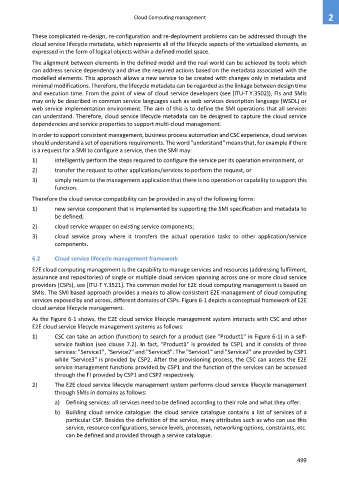Page 507 - Cloud computing: From paradigm to operation
P. 507
Cloud Computing management 2
These complicated re-design, re-configuration and re-deployment problems can be addressed through the
cloud service lifecycle metadata, which represents all of the lifecycle aspects of the virtualized elements, as
expressed in the form of logical objects within a defined model space.
The alignment between elements in the defined model and the real world can be achieved by tools which
can address service dependency and drive the required actions based on the metadata associated with the
modelled elements. This approach allows a new service to be created with changes only in metadata and
minimal modifications. Therefore, the lifecycle metadata can be regarded as the linkage between design time
and execution time. From the point of view of cloud service developers (see [ITU-T Y.3502]), FIs and SMIs
may only be described in common service languages such as web services description language (WSDL) or
web service implementation environment. The aim of this is to define the SMI operations that all services
can understand. Therefore, cloud service lifecycle metadata can be designed to capture the cloud service
dependencies and service properties to support multi-cloud management.
In order to support consistent management, business process automation and CSC experience, cloud services
should understand a set of operations requirements. The word "understand" means that, for example if there
is a request for a SMI to configure a service, then the SMI may:
1) intelligently perform the steps required to configure the service per its operation environment, or
2) transfer the request to other applications/services to perform the request, or
3) simply return to the management application that there is no operation or capability to support this
function.
Therefore the cloud service compatibility can be provided in any of the following forms:
1) new service component that is implemented by supporting the SMI specification and metadata to
be defined;
2) cloud service wrapper on existing service components;
3) cloud service proxy where it transfers the actual operation tasks to other application/service
components.
6.2 Cloud service lifecycle management framework
E2E cloud computing management is the capability to manage services and resources (addressing fulfilment,
assurance and repositories) of single or multiple cloud services spanning across one or more cloud service
providers (CSPs), see [ITU-T Y.3521]. The common model for E2E cloud computing management is based on
SMIs. The SMI based approach provides a means to allow consistent E2E management of cloud computing
services exposed by and across, different domains of CSPs. Figure 6-1 depicts a conceptual framework of E2E
cloud service lifecycle management.
As the Figure 6-1 shows, the E2E cloud service lifecycle management system interacts with CSC and other
E2E cloud service lifecycle management systems as follows:
1) CSC can take an action (function) to search for a product (see "Product1" in Figure 6-1) in a self-
service fashion (see clause 7.2). In fact, "Product1" is provided by CSP1 and it consists of three
services: "Service1", "Service2" and "Service3". The "Service1" and "Service2" are provided by CSP1
while "Service3" is provided by CSP2. After the provisioning process, the CSC can access the E2E
service management functions provided by CSP1 and the function of the services can be accessed
through the FI provided by CSP1 and CSP2 respectively.
2) The E2E cloud service lifecycle management system performs cloud service lifecycle management
through SMIs in domains as follows:
a) Defining services: all services need to be defined according to their role and what they offer.
b) Building cloud service catalogue: the cloud service catalogue contains a list of services of a
particular CSP. Besides the definition of the service, many attributes such as who can use this
service, resource configurations, service levels, processes, networking options, constraints, etc.
can be defined and provided through a service catalogue.
499

